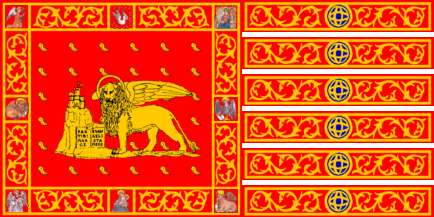 image
by M. Schm÷ger, 14 August 2002
image
by M. Schm÷ger, 14 August 2002
Last modified: 2021-08-24 by rob raeside
Keywords: italy | veneto | st. mark | winged lion | serenissima | venice | venezia |
Links: FOTW homepage |
search |
disclaimer and copyright |
write us |
mirrors
 image
by M. Schm÷ger, 14 August 2002
image
by M. Schm÷ger, 14 August 2002
See also:
Other Sites:
The flag of Venice (capital of Veneto)
is red with yellow ornament, and near the hoist a red field with
the lion in red and the same book open.
Pascal Vagnat, 22 September 1998
The Italian city of Venezia adopted a new flag, a new gonfalon
a new coat of arms and a new seal in 1996 and 1997. The new coat
of arms and the new gonfalon were adopted with a presidential
decree on the 6th November 1996. The new flag and the new seal
were adopted with a presidential decree on the 8th January 1997.
All the emblems were presented on a ceremony on Friday 22nd May
1998 at 11.am in the Ducal palace in Venezia with people in
middle-ages costumes.
One can see all these emblems at <www.clodianet.it>.
Follow the link "Il nuovo stemma della Città di
Venezia" (The new coat of arms of the city of venezia) or
<www.clodianet.it/araldica>
(follow then gonfalone (bottom) and bandiera (bottom) to see
their pictures). On these beautiful and interesting (even for non
Italian speaking people) pages are to be seen the big images of
the coat of arms (stemma), the seal (sigillo), the flag
(bandiera), the gonfalon (gonfalone). Follow each times the link.
There is a very detailed and legal information concerning the
emblems of Venezia through the history.
Other pages shows the coat of arms, the seal, the flag and the
gonfalon of the province of Venezia; the image of the different
civic crown in use in Italian heraldry (region, province, city,
commune, etc...) as well as example of use of these crowns. These
pages are really impressive with the information given and the
high quality of the images. However if the picture of the flag of
Venezia is big, there is a lack of zoom on some parts of it.
Pascal Vagnat 8 November 1998
The city adopted its new symbols with presidential decree in
1996 and 1997. The coat of arms is the same than the former one
without any connotation of fascism or bundle of lictors. The
gonfalon is red bordered with gold ornament and four armillary
azure and gold spheres. The coat of arms appear in the middle
with the words "CITT└' DI VENEZIA" (city of Venice).
There are other precise ornamental details. There is also a seal
and a flag. The flag is 100 x 200 cm, res semÚe with golden
flames, bordered red, ornamented with gold, charged with the
following emblems: the archangel Gabriel, the Holy Dove, the Happy
Virgin of the Annunciation, the symbol of the Evangelist Saint
Matthew, the Happy Virgin with the Holy son, the symbol of the
Evangelist Saint Luke, the symbol of the Evangelist Saint Mark,
the symbol of the Evangelist Saint John (all these pictures in
natural colours). The flag is charged with the lion of Saint Mark
passant with the Holy Book open and the words (see supra), the
earth, the sea, a castle of three towers. The end of the flag has
seven tongues red, gold ornamented charged in their centres with
azure wheels charged with armillary golden spheres. There are
other details.
Pascal Vagnat 9 November 1998
I think that in the pages of the book held by the lion should appear only four (4) lines instead of the five that I see. Nowadays, in the pages of the book the inscription is :
| left page (even) | right page (odd) |
| PAX | EVAN |
| TIBI | GELI |
| MAR | STA |
| CE | MEUS |
These pieces of word make together the Latin phrase 'Pax tibi,
Marce, evangelista meus' ('Peace to you, o Mark, my evangelist')
.
Diego Nobili 10 November 1998
This flag is listed under number 49 at the chart "Flags
of Aspirant Peoples" [eba94].
Ivan Sache , 16 September 1999
The quotation is not biblical. It is from a mediaeval
legend that an angel appeared to St. Mark when he was traveling
from Aquileia (at the head of the Adriatic) to Rome and said to
him "Pax tibi, Marce, evangelista meus. Hic requiescet
corpus tuum," (Peace unto thee Mark my evangelist.
Here your body will rest.) Since the text is not biblical,
I conclude that the book cannot be a bible.
Joe McMillan, 9 March 2001
Above is the current flag, as granted on 8 January 1997.
Source: [ald98].
M. Schm÷ger, 14 August 2002
This is the city flag. I have a photo. In the photo the red
shade is darker. This flag seems to be based on the one from the
XVII century but it has some variations from it. I believed that
before this flag, the flag from 1942 until 1997 was the Italian
one but with a red square in canton baring the lion (see Historical Flags of Venice), but perhaps
there was an intermediate version 1996/97-1997/98 with dark red
shade?
I believe that the flag presentation was made Friday 22 May 1998.
The old (?) flag was still used until this day.
Jaume OllÚ, 18 August 2002
Indeed, from 1942 to 1997 the official flag of the city of
Venice was the Italian tricolore with the lion in the canton.
However, variants of the traditional flag with the lion, similar
to the 1997-present flag, were used unofficially. As far as I can
see, the shades of the red varied considerably, although I admit
that the official drawing depicted in [ald98]
shows a darker red than just 255-0-0 red. The presidential decree
only speaks of "rosso" (red) and doesn't specify it
more thoroughly.
M. Schm÷ger, 19 August 2002
I found some background on the use of the Lion of St. Mark for
Venice in John Julius Norwich's A History of Venice (New
York: Knopf, 1982; originally published in the UK as Venice
(2 vols.) by Allen Lane, 1977 and 1981).
Citations below are from the Knopf edition.
Page 11--The association of St. Mark with Venice traces back to
the tradition that the Evangelist founded the see of
Aquileia. As a result of several schisms, the patriarchate
of St. Mark was claimed by the metropolitan of Grado, later
subsumed by Venice, in the 6th century.
Pages 52-53--"On 9 May, AD 1000--it was Ascension Day--the
Doge heard Mass in the cathedral of S. Pietro di Castello, and
received from the Bishop of Olivolo a consecrated
standard." Norwich's footnote to this says
"Gfro"rer believes that this banner bore, possibly for
the first time, the now familiar Venetian emblem of the winged
lion with the open book in its paws."
The citation is to A. F. Gfro"rer's Byzantinische
Geschichten, ed. J. B. Weiss, 3 vols. (Graz, 1872-7).
Page 134, quoting the French chronicler Geoffrey de
Villehardouin, describing Doge Enrico Dandolo's 1203 amphibious
attack on Constantinople in the Fourth Crusade: "For
the Duke of Venice, who was an old man and stone blind, stood
fully armed on the prow of his galley, with the banner of St.
Mark before him, and cried out to his men to drive the ship
ashore if they valued their skins. And so they did, and he
and they leapt down and planted the banner before him in the
ground. And when the other Venetians saw the standard of
St. Mark and the Doge's galley before their own, they were
ashamed, and followed him ashore."
Illustration 28, facing page 197, shows a black and white photo
of a picture of this event from Villehardouin's original
manuscript with two light colored flags flying from the stern of
a Venetian boat, both with what appear to be dark-colored winged
lions, possibly red on yellow.
Joseph McMillan , 21 February 2000
History of flag usage by the Republic of Venice, drawn from
John Julius Norwich, A History of Venice (New York: Knopf, 1982)
and the story of how St Mark came to be the patron of Venice and
the winged lion of St Mark to be its symbol.
From pages 10-11: Invasions by the Lombards in the 6th-7th
centuries caused inhabitants of coastal communities to flee en
masse to the islands of the Adriatic lagoons. "For the
later history of the Republic the most important of these flights
from Lombard domination was also one of the first [ca. 639]--that
from Aquileia to Grado. The see of Aquileia had
traditionally been founded by St Mark himself, in consequence of
which its metropolitan Archbishop--later to bear the title of
Patriarch--was supreme in the lagoons, occupying a place in the
Italian hierarchy second only to that of the Pope of
Rome." Schisms over the course of years led to rivalry
between the patriarch at Grado and a reestablished see at
Aquileia, "but it was the Patriarch of Grado who occupied
the ancient Episcopal throne in which St Mark had once sat....
[This] begins the association of St Mark with Venice which was
merely to be confirmed when his body was brought from Alexandria
some 250 years later."
From pages 28-30: "One day--so the story goes--when St
Mark was traveling from Aquileia to Rome, his ship chanced to put
in at the islands of Rialto. There an angel appeared to him
with the words 'Pax tibi, Marce, evangelista meus. Hic requiescet corpus tuum.' The historical evidence for this
story is, to say the least, uncertain; the prophecy--since St
Mark later became Bishop of Alexandria and remained there till he
died--would have seemed improbable; but the legend certainly came
in very handy when, in 828 or thereabouts, two Venetian merchants
returned from Egypt with a corpse which they claimed to be that
of the Evangelist, stolen from his Alexandria tomb. . . . That a
body generally thought to be that of St Mark was brought to
Venice at this time is generally believed to be a historical
fact." Doge Giustiniano Participazio ordered the
construction of a special chapel attached to his own palace for
the enshrinement of the relics. "His decision to
preserve [the body] in an obvious dependency of his own palace
deliberately associated it with the civil rather than the
religious authorities of the state. From that moment on,
old St Theodore and his dragon [the previous patron saint of the
city] were relegated to the top of a column in the Piazzetta and,
for all practical purposes, forgotten. St Mark became the
patron of Venice. His lion, its wings outstretched, its
forepaw proudly indicating the angelic utterance, was to be
emblazoned on banners and bastions, on poops and prows, whenever
and wherever the Venetian writ was to run."
Joseph McMillan , 10 March 2001
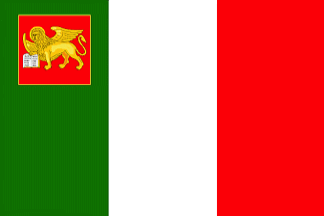 image
by Roberto Breschi from CISV
image
by Roberto Breschi from CISV
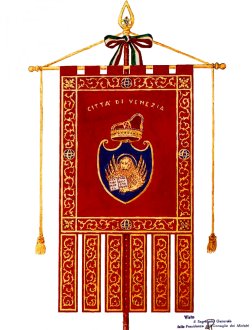
from <www.iagi.info>
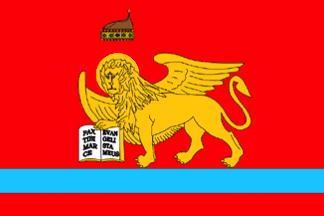 image
by Jaume OllÚ, 14 November 1998
image
by Jaume OllÚ, 14 November 1998
The ceremonial (gail) flag of the city of Venice. In the
ceremonial (gail) flag a ducal (?) crown appears above the head of lion. The
same flag seems to be the duke's standard. I don't have
notes or dates about this flags
Jaume OllÚ, 14 November 1998
The civic flag of Venice is the Italian tricolour with a red
square placed on the upper half of the green stripe and with the
golden lion of S. Mark on it. This flag was confirmed and
slightly modified on 1st May 1942. Naturally everybody knows the
civic gonfalon rather than this flag. The Venezia province and
the Veneto region have also flags that look like the gonfannon,
increasing the historical confusion about Venetian flags.
Mario Fabretto, 20 September 1996
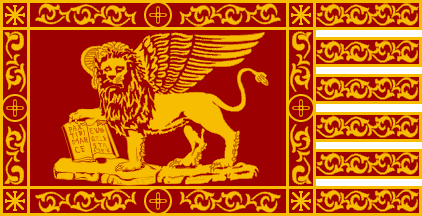 image
by Jaume OllÚ, Mello Luchtenberg & Tomislav Todorovic, 26 June 2019
image
by Jaume OllÚ, Mello Luchtenberg & Tomislav Todorovic, 26 June 2019
See also photo from
"Adria Bandiere" catalogue.
See also: Veneto
ve-ve.gif) image
from <www.araldicacivica.it>
image
from <www.araldicacivica.it>
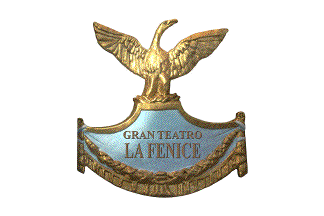 image by Ivan Sache, 14
September 2010
image by Ivan Sache, 14
September 2010
The opera house Gran Teatro La Fenice (Grand Theater "The Phoenix"), usually
known as La Fenice, was inaugurated on 16 May 1792 in Venice. Designed by the
architect Gian Antonio Selva, La Fenice replaced the San Benedetto Theater,
which had been destroyed in 1789 in a blaze, therefore its name, alluding to the
mythological bird able to arise again from its own ashes. Burned again in 1832,
the opera house was rebuilt again. On 29 January 1996, a criminal blaze
destroyed La Fenice for the second time; with the help of the UNESCO, the opera
house was rebuilt "com'era e dov'era" (as it was and where it was) after years
of controversy and eventually reinaugurated on 12 November 2003.
Considered as one of the world's temples of bel canto, La Fenice
enjoyed the first appearance of several famous operas, including Rossini's "Tancredi"
(6 February 1813) and "Semiramide" (3 February 1823), Bellini's "I Capuleti e i
Montecchi" (11 March 1830) and "Beatrice di Tenda" (16 March 1833), Donizetti's
"Belisario" (4 February 1836), and Verdi's "Ernani" (9 March 1844), "Attila" (17
March 1846), "Rigoletto" (11 March 1851), "La Traviata" (6 March 1853) and
"Simon Boccanegra" (12 March 1857). "La Traviata" was played in 2003 for the
inauguration of the modern Fenice.
La Fenice is the decor, if not the
"main character" of the first scene of the movie "Senso", filmed in 1954 by
Lucchino Visconti (1906-1976). Based on the short novel of the same name
published in 1883 by Camillo Boito (1836-1914, mostly known as the brother of
the composer and librettist Arrigo Boito [1842-1918]), the movie relates a love
affair between an Italian countess and an Austrian officer. Visconti and the
scenarist Suso Cecchi d'Amico (1914-2010) have dramatically changed Boito's
novel, putting the emphasis on the political struggle of the Italian patriots
against the Austrian occupation. The Fenice scene, not found in Boito's novel
and often considered as Visconti's esthetic manifesto, shows the Italian
patriots transforming the third act of Verdi's "Il Trovatore" into a nationalist
demonstration; at the end of the scene, the patriots throw down green, white and
red sheets of paper ("reconstructing" the Italian flag) down to the Austrian
officers sitting in the orchestra.
http://www.youtube.com/watch?v=gnJliUutkWQ
[In memoriam, Suso Cecchi
d'Amico, d. 31 July 2010, author of coauthor of so many Italian masterpiece
movies]
On 6 September 2007, the beloved Italian tenor Luciano Pavarotti
(1935-2007) died in Modena. As a sign of mourning, the Vienna opera house
hoisted a black flag, a honour until then strictly reserved to its honour
members. The flag of La Fenice was half-staffed and added a black sash, as shown
on a photo credited to SIPA agency.
http://www.gala.fr/l_actu/c_est_officiel/la_mort_de_pavarotti_provoque_une_ferveur_sans_precedent_en_italie
The flag of La Fenice is white with the Fenice's emblem, made of a
golden phoenix standing on a light blue theater curtain charged with the golden
letters "GRAN TEATRO / LA FENICE".
http://www.youtube.com/watch?v=O0Sx5lbVlQA
[In memoriam, Luciano
Pavarotti's farewell to music - his last public performance during the opening
ceremony of the Turin Olympic Games 2006]
Ivan Sache, 14 September
2010
In spite of the impression given by the picture you found on gala.fr, the
Fenice's flag is not white but very light blue with the emblem. Here is
a picture I took where it might be more
obvious - but the blue is so light that it is not easy to see it on a
photograph.
Olivier Touzeau, 17 September
2010